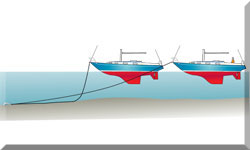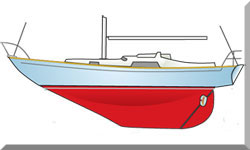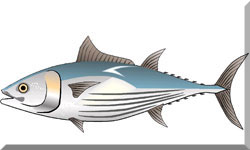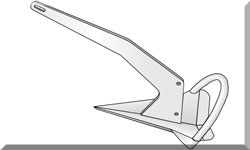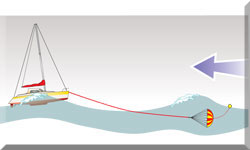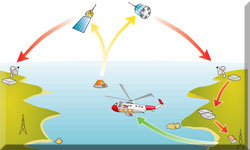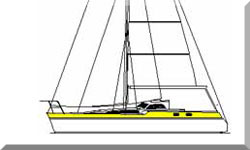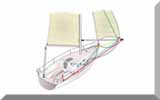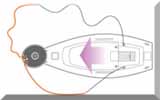- Home
- Choosing Accessories
- Parachute Sea Anchor Issues
Parachute Sea Anchor Issues: Your Questions Answered
A parachute sea anchor can be your best friend when the weather takes a turn for the worse. It helps keep your boat steady, slows your drift, and keeps your bow facing the waves.
But using one can bring up lots of questions. How do you set it up? When should you use it? How do you take care of it? From simple tips to must-know tricks, this guide answers the most common questions.
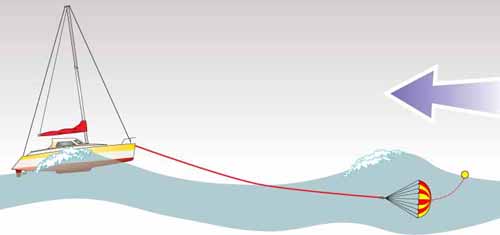 A parachute sea anchor is always deployed from the bow
A parachute sea anchor is always deployed from the bowCruisers are asking...
What is a parachute sea anchor, and how does it differ from a drogue?
What is a parachute sea anchor, and how does it differ from a drogue?
A parachute sea anchor is an underwater parachute designed to create substantial drag in the water. It stabilizes a boat by keeping its bow pointed into the wind and waves during rough conditions, reducing the risk of capsizing, broaching, or drifting uncontrollably. This mechanism is particularly valuable when a vessel cannot make progress or maintain control in stormy weather.
A drogue, on the other hand, is smaller and is typically deployed from the stern to slow the vessel down and keep it aligned when running with the wind and waves. While both devices provide stability, their applications are different. For recreational sailors, understanding when to use each device can be critical—parachute sea anchors are for halting forward motion entirely, while drogues are for controlled movement.
How do I deploy a parachute sea anchor?
How do I deploy a parachute sea anchor?
Deploying a parachute sea anchor requires preparation and proper technique. First, securely attach the rode to a reinforced point on the bow (a cleat or bollard designed for heavy loads). The rode should include a swivel to prevent twisting, and its length should account for water depth and anticipated wave conditions (e.g., 5-10 times the depth).
Before deploying, ensure the parachute is packed in a way that allows it to unfurl smoothly—some anchors come with deployment bags for ease. Once deployed, it will open underwater and create drag. It’s essential to monitor the rode for chafe at contact points and maintain readiness for retrieval.
Recreational sailors should also consider conditions before deploying. For instance, it is crucial not to deploy the anchor in shallow waters where its effectiveness may be compromised or where it risks entanglement with underwater obstacles.
What size parachute sea anchor do I need for my boat?
What size parachute sea anchor do I need for my boat?
Selecting the correct size is vital for optimal performance. Generally, the larger the vessel (in terms of length and displacement), the larger the parachute sea anchor required. For example, small recreational boats (e.g., 25–30 feet) might use parachutes with a diameter of 9–12 feet, while larger yachts may require parachutes of 18 feet or more.
For boat owners, consulting manufacturer sizing charts or experienced sailors can help with the selection. Additionally, oversized parachutes can cause unnecessary strain on the rode and attachment points, while undersized ones may fail to stabilize the boat effectively.
Should I use a bridle on my multihull?
Should I use a bridle on my multihull?
Yes, multihulls require a bridle to evenly distribute the load between the hulls. Without a bridle, the force exerted by the parachute anchor can cause structural strain or create uneven tracking, potentially leading to hull damage or instability.
A bridle setup involves attaching two separate lines—one to each hull—joined at a central point where the main rode is connected. When rigging a bridle, ensure the angles are correct to prevent the vessel from yawing excessively. Many multihull sailors use stretchable materials, such as nylon, for the bridle lines to reduce shock loads in heavy seas.
How do I prevent chafe on the rode?
How do I prevent chafe on the rode?
Chafe is a common concern, especially during prolonged use in harsh conditions. To protect the rode, employ chafe guards at all points of contact. These can include nylon tubing, leather sleeves, or purpose-made chafe gear designed to handle high abrasion.
For offshore sailors, inspecting the rode periodically during deployment is crucial. If chafe gear is unavailable, temporary solutions such as duct tape or cloth can provide some protection, but these are less effective than dedicated equipment. Always ensure the rode remains free of sharp edges and excessive friction.
Can I use a parachute sea anchor in storm conditions?
Can I use a parachute sea anchor in storm conditions?
Absolutely—parachute sea anchors are specifically designed for severe weather scenarios. They stabilize the vessel and reduce the impact of breaking waves by keeping the bow aligned with the incoming seas.
However, storm use requires careful preparation. Recreational sailors should double-check all equipment, ensure the rode is free of knots, and monitor the anchor throughout the deployment. Familiarizing yourself with the procedure before encountering a storm is advisable to minimize risk in high-stress situations.
How do I retrieve a parachute sea anchor?
How do I retrieve a parachute sea anchor?
Retrieving a parachute sea anchor involves collapsing it first, usually via a trip line. The trip line allows you to invert or deflate the parachute, making it easier to pull back onto the vessel. Some anchors come with dedicated retrieval lines built into their design for convenience.
After retrieval, rinse the parachute with fresh water to remove salt and debris as soon as convenient, and allow it to dry completely before storage. Proper maintenance ensures the anchor remains in good condition for future use—a detail offshore sailors should prioritize.
What are common mistakes when using a parachute sea anchor?
What are common mistakes when using a parachute sea anchor?
Mistakes include:
- Improper Rigging: Failing to use reinforced points or swivels can lead to equipment failure.
- Insufficient Rode Length: Short rode lengths reduce the anchor's effectiveness and increase the risk of the parachute collapsing.
- Chafe Neglect: Without proper protection, chafe can weaken or damage the rode, potentially leading to loss of the anchor.
- Deploying in Shallow Waters: This can limit the parachute's ability to open fully or lead to entanglement.
- Ignoring Manufacturer Instructions: Each parachute sea anchor may have unique specifications; ignoring them can reduce performance or cause damage.
Will saltwater damage the parachute sea anchor?
Will saltwater damage the parachute sea anchor?
Modern parachute sea anchors are made from materials like heavy-duty nylon, which resist saltwater damage, UV degradation, and mildew. Despite this durability, prolonged exposure to saltwater can eventually reduce their lifespan if not maintained properly.
Cruisers should rinse the sea anchor with freshwater after each use, check for wear and tear, and store it in a cool, dry place to prevent long-term damage.
What is the difference between lying ahull and using a parachute sea anchor?
What is the difference between lying ahull and using a parachute sea anchor?
Lying ahull involves allowing the boat to drift naturally with the wind and waves. While it might work in moderate conditions, it leaves the vessel vulnerable in severe weather, as waves can hit the boat from unfavorable angles.
A parachute sea anchor offers far superior stability by maintaining a bow-forward position against the wind and waves, reducing the risk of broaching, capsizing, or being swamped. Recreational sailors should opt for a parachute sea anchor in extreme conditions rather than relying on lying ahull.
Recent Articles
-
The Hunter 466 Sailboat
Apr 29, 25 03:32 AM
The Hunter 466 sailboat specs and KPIs set out here tell us much about how this B&R rigged sailboat is likely to behave in a seaway... -
Which Type of Boat Fridge Is The Most Efficient?
Apr 24, 25 05:06 AM
The top opening boat fridge is reputed to be more efficient than the front opening type, but that may not be the case - and here, amongst other boat refrigeration considerations, is why -
Multihull Autopilot Selection is Not Straightforward
Apr 19, 25 01:25 PM
Whether its for a catamaran or a trimaran, tiller or wheel steered, a multi hull autopilot must be endowed with specific performance characteristics...

